Townlands of Kilcommon
There are 37 townlands in the modern civil parish of Kilcommon, County Mayo, Ireland. Some of these are:
Aughoose

Aughoose townland (Irish: Na hEachú[1]) is on the Dún Chiortáin peninsula overlooking the lower reaches of Sruth Fada Conn Bay. It consists of 898 acres (3.63 km2). There was a little chapel along the stream at Lenamore in the 18th century (a rare sight due to the Penal Laws at that time). Until the 1950s Aghoose had a dance hall where the young people flocked from outlying areas. There was a lace school organised by the Congested Districts Board. Lace schools were at their prime during the World Wars when they made buttons for uniforms and other goods for foreign armies. Later on they turned to knitted and crocheted goods. From the early 20th century local headquarters of the Lady Dudley Nursing Scheme was based at Aghoose. The nurses based here cared for patients across the whole parish. In the early 1970s, the Nursing Scheme was absorbed into the current Health Services structure. Aghoose townland is close to Bellanaboy where the Corrib Gas pipeline tunnel is proposed to come above ground again. The people of Aghoose are opposed to the development but a large portion of Lenamore has been sold to Shell.
Barnatra
Barnatra (Irish: Barr na Trá[2]) straddles the parishes of Kilcommon and Kilmore at the lower end of Broadhaven Bay. Situated at a crossroads, its roads lead westwards into Belmullet and the Mullet Peninsula, northwards out the Dun Chaocháin peninsula to Glengad and Pollathomas, eastwards to Glenamoy and the Céide Fields and southwards to Carrowmore Lake, Bangor Erris and hence eventually to Castlebar and Ballina some 80 km distant. John Healy runs a fairly large general store, shop and petrol station at Barnatra which serves much of the Kilcommon area.
Bellanaboy
The townland of Bellanaboy (Irish: Béal an Átha Buí[3]) consists of an area of 1,050 acres (4.2 km2), most of which is now enclosed around a fossil fuel refinery under heavy security which has been built on Irish government Coillte controlled afforested conifer plantation land by Royal Dutch Shell. The townland is situated at the most south easterly point of the Sruwaddacon Bay estuary. The Aughoose River, also known as the Yellow river flows through the townland on its way to Carrowmore Lake, the drinking water supply for the whole of Erris. Found along the river bed is the soft yellow subsoil which gives the townland its name. The townland has flooded many times over the years and people have been killed in these floods.[4] In the 19th century the home of the Swift family in this townland was a well known house of hospitality where any travellers were welcomed for overnight stays as they travelled between Belmullet and Ballycastle/Killala.
Carrowteige
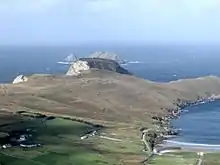
Carrowteige (Irish: Ceathrú Thaidhg[5]) is a Gaeltacht village situated close to the end of the Dún Chaocháin peninsula. It consists of 403 acres (1.63 km2). It has a Catholic church, a national school and a shop. Comhar Dún Chaocháin Teo is based in this village and way-marked cliff walks start from here.
Cill Ghallagháin
Cill Ghallagáin[6] (English: Kilgalligan) is a coastal townland situated on the extreme north tip of the Dun Chiortáin peninsula in Kilcommon parish. There is a small village of the same name. It is a wild and rugged place overlooking Broadhaven Bay and the wider Atlantic Ocean. Notable for its massive microtoponymic collection and its ancient graveyard situated on the northern side of Sruwaddacon Bay.
Cornboy
Cornboy is a coastal townland on the Dún Chaocháin peninsula. It extends 2,755 acres (11.15 km2) in size. The village centre is now situated as far inland as the townland extends, close to Garterhill td. In the past the centre of population was based around the old chapel on the hill overlooking Broadhaven Bay. The people once lived further down close to Cornboy Pier but over the years blowing sand has moved the centre of population further from the extensive sand dune areas.
There is an area known as the 'Sandhills Settlement' which consists of settlement features, possibly cairns and middens where a population lived (possibly Iron Age). It is a large area consisting of large sand dunes and sandy beaches which sometimes becomes exposed after a storm but the next storm covers it up again with deep sand. The Gweedaney River rises at Portacloy and flows past the old chapel in the dunes into Sruth Fada Conn bay. The modern church is situated much further inland. Cornboy shares Knockadaff mountain with Garter Hill. Knockadaff was an electoral district of the Belmullet Poor Union and was a local administrative body of Erris. Cornboy was, at the end of the 19th century the most progressive village in the area. These days it has a community centre which serves meals at lunch-time and is a centre where some classes take place for local people.
Cornhill
Cornhill (Irish: Gort an Chairn[7]) is a village situated on Dooncarton Hill. It overlooks Sruth Fada Conn bay. The village itself has many fields of which most are used for animals. The radar tower on Dooncarton Hill is situated directly in front of the village. Many have said that the radar tower is an eyesore and should be taken down but it is still standing. The village itself is a linear village with roughly 13 houses.
Faulagh
Faulagh (Irish: Fálach[8]) Village lies on the southern slopes of the mountain of the same name overlooking Carrowmore Lake. Its area is 946 acres (3.83 km2) lying along the northern boundary of Carrowmore Lake. This remote spot, is mostly blanketed in bog. There are many prehistoric megaliths and prehistoric field systems across its landscape and that of its neighbour, Muingerroon td.
Glenamoy

Glenamoy (Irish: Gleann na Muaidhe[9]) is a general name for nine Kilcommon townlands - Bellagelly North & South, Baralty, Bunalty, Gortleatilla, Srahnaplaia, Pollboy, Lenarevagh and Barroosky. Glenamoy consists of some 16,700 acres (68 km2) of land, much of it blanket bog interspersed with small lakes and conifer forestry, some of it pretty inaccessible and remote. It lies inland from the coastal townlands of the parish. The Glenamoy River and the Owenmore rivers rise in the mountains above Glenamoy. The Owenmore River flows into Blacksod Bay, the Glenamoy River into Broadhaven Bay. Lace schools were one of the more common industries in the area in the past.[10] There were several shooting lodges in this area where the landlords held shooting parties for the gentry in the 19th century. Nowadays, mostly small farms and football are the interests of the inhabitants.
Glengad

Glengad, also known as Dooncarton (Irish: Gleann an Ghad[11]), is a large townland stretching along the north western shores of Sruwaddacon Bay. Its name is derived from willows or 'gads' from the Cromwellian period when the native Irish were sent "to hell or to Connaught". The settlers who came to Glengad brought with them the craft of basket weaving. They planted willow branches on wet sites in the townland and willows have grown in the streams of Glengad ever since. It is a linear village with individual houses and farms all along the main road. The land here was divided up by the Land Commission in the early 20th century and each farm is a narrow strip of land which runs from the mountain down to the sea, a remnant of the Rundale System of farming which can be seen in many areas of the parish. In recent years Glengad has been the scene for much of the Corrib gas controversy.
Glinsk
_Stone_Circle.jpg.webp)
Glinsk (Irish: Glinsce[12]) is a remote townland in Erris, North West Mayo. Glinsk Mountain is covered with blanket bog and rises steeply to overlook Broadhaven Bay and the Stags of Broadhaven, pictured below, from very high vertical cliffs continuing from the spectacular Benwee Head cliffs. Its area covers 2,054 acres (8.31 km2). There are currently no human inhabitants of this townland and the road past it was only tarred for the first time in 2004. There is the ruins of a 1798 English watch tower on the southern slopes of Glinsk mountain.
Gortbrack
Gortbrack (Irish: An Gort Breac[13]) td. occupies a large section of the southern side of the western peninsula, Dun Chiortain. It is 1,070 acres (4.3 km2) in size. The Owenduff River flows through the townland It has much of archaeological interest due to its location along the south facing slopes along the coastline. There are many megaliths dating from the Neolithic period.
Gortmelia
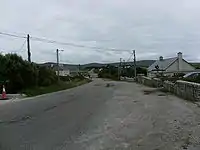
Gortmelia (Irish: Gort Meille[14]) is on the west side of the Dún Chiortáin peninsula overlooking Inver Bay. It is 1,237 acres (5.01 km2) in size. In the Tithe composition Book of 1834, Gortmelia was divided into three parts - Gortmelia Mills, Gortmellia Gallagher and Rookstown. Later in the rateable valuation Books the three areas are called Gortmellia Mills, Gortmellia Gallagher and Gortmellia Houston. Today, the townland is in four areas: Gortmellia, Parkbaun, Ballur and Ballyhonry.
Inver
Inver (Irish: An tInbhear[15]) townland, area 663 acres (2.68 km2) townland is situated on the western side of the Dún Chiortán peninsula overlooking Trá Kirtaan (Chiortáin's Beach). The Owenduff River which rises in Knocknalower td. flows into Broadhaven Bay through Inver td. In 1636 Michael Cormuck lived in Inver Castle which was built close to the shore. While Cormuck laid claim to much of the land in Erris, the Protestant bishop had, according to the Stafford Inquisition of Mayo which investigated the ownership of land in the county in the early 17th century, the "right of the sea all around Erris".[16][17][18] The castle had fallen by 1802 and on its site today there is very little to be seen except its gate posts. Many cottages locally, now mostly in ruins, are constructed of particularly well-masonried stone blocks, so presumably the castle was pilfered of its stonework due to population pressure in the years between 1802 and the Irish Famine some 40 years later. Several ships of the Spanish Armada and many other ships were lost on the rugged coastline of the Dún Chiortán peninsula over the years. The 17th-century story of Brian Rua relates just such a story. This townland was the centre of sporting activity down through the years. Sports such as horse-racing and curragh racing were held at the Inver sand-banks. There are many megalithic relics in the Inver area. It is a pretty place on the southern slopes of the hills and gets a lot of sunshine throughout the year. This townland features in the story of the Táin Bó Flidhais and an archaeological mound found in Inver is alleged to be the burial place of the unfortunate husband of Flidhais when left stranded by the Kilcommon Celtic hero, Chiortain, after whom this peninsula is named.
Pollathomas
Situated on the Dún Chiortáin peninsula and also known as Poll a tSómais,[19] Pollatomais, Kilcommon, Pullathomas (the most commonly used spelling) and Pollatomish, this townland consists of 673 acres (2.72 km2). Pollathomas village has had a substantial population throughout the years. The village straddles a small crossroads and has a lovely location with views over Sruwaddacon Bay. It has a post office/shop, a busy hostel, a couple of pubs, a national school and a sizeable population. The graveyard had a 6th-century religious establishment of St. Coman which was mentioned in the Annals of the Four Masters. When the Anglo Normans came to Ireland there were several slayings recorded of the new English by the native tribespeople.[20] In 1585 during the Reformation Pollathomas became the property of the Protestant Bishop of Killala and Michael Cormuck who lived at Inver Castle was the lessee. Several religious settlers including the Augustinians, were driven out of the area during the Penal Laws period of the 17th century. In 1770 Pollathomas and Glengad were leased from the Protestant Bishop by the O'Donel's of Termon, and Kilcommon Lodge, now a thriving hostel was built.[21]

Famine and devastation hit Pollathomas several times in the 19th century before the Irish Famine of 1845/47 due to sheer pressure of population. During the Great Famine of 1845/47 the little relief came from the Quakers when the response for provisions to be sent to the area urgently, was to turn down the request. The people ate seaweed and sea-gulls eggs.[22] The landlord, James O'Donel was attacked in Kilcommon Lodge. He demanded that a police barracks be built to protect his family but none was ever built. He bred crows and nurtured them so that they would protect his property.[23] Throughout the 19th century, evictions and proselytising were commonplace. It is now a quiet village, occasionally affected by the rumblings of the Corrib gas project with a couple of public houses (Maguires and McGraths), a general store and post office and Kilcommon Lodge Hostel, a popular destination for visitors to the area.
Portacloy
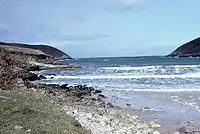
Portacloy (Irish: Port an Chlóidh[24] is townland on the north of the Dún Chaocháin peninsula consisting of 922 acres (3.73 km2) on the western boundary of Porturlin, it is set around a picturesque horseshoe shaped bay with a sandy beach and water, a couple of piers and several cliff walks. Carrowteige has its nearest shop. There is the remains of a promontory fort and an English watchtower here. The Government neglected Portacloy as a fishing port, building a harbour in Porturlin instead but in 1909 a boat slip, breakwater and landing place were built to facilitate the fish curing station which had been built a few years earlier to process mackerel. In the 1960s a second small pier was built. Portacloy still remains a peaceful pleasant cove.
Porturlin
Porturlin (Irish: Port Durlainne[25]) is a coastal townland on the east coast of the Dún Chaocháin peninsula consisting of 2,120 acres (8.6 km2). During the famine, Richard Webb, bringing relief for the distressed from the Society of Friends described it as the finest fishing grounds in Mayo but wrote that "the only access by land is over a high and boggy mountain, so wet and swampy that it is difficult to reach it even in summer. There is probably not in Ireland, a cluster of human habitations so completely secluded from easy access...".[26] When William Bald had been carrying out improvement works in the Erris area in 1835 he recommended building piers at Porturlin and in Portacloy, claiming it would aid the fishermen of the area greatly. During the 1840s roads were made to the area. In 1886 the Roads and Harbour Commissioners finally built a landing slip 210 feet (64 m) in length at a cost of £204.00. The Congested Districts Board for Ireland erected a curing station for herring and mackerel in 1894. By 1952 the old pier had fallen asunder and was replaced in 1965 by Mayo County Council.
In February 2010, Pat 'The Chief' O'Donnell, owner of a fish processing plant in Porturlin and fifth-generation fisherman served a contested seven-month sentence in Castlerea Prison for his participation in protests against the Corrib gas project which he believes poses an unacceptable risk to the area, including his own livelihood and that of all fishermen in the Broadhaven Bay area.[27]
Rossport/Ros Dumhach
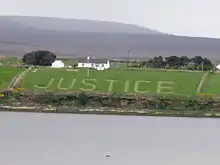
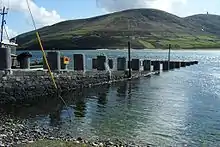
Rossport (Irish: Ros Dumhach[28]) has an area of 1,446 acres (5.85 km2). There is a national school and the Gaelic speaking secondary school, Colaiste Chomain in Rossport. There have been many suggestions over the years to build a bridge across the 'ferry' to connect Rossport with the Dún Chiortáin peninsula as it is very close as the crow flies but a very great distance by vehicle. The flowing and ebbing tides of Sruwaddacon Bay are hazardous even for the most experienced boatman. The words of a song describe the rapidity of the current:
The Rossport Ferry and its rapid current
The second strongest that our State possesses
In more recent years, Rossport has been the scene of conflict with the Corrib gas project and protests against same.
Srahataggle
Srahataggle (Irish: Sraith an tSeagail[29]) townland consists of 4,167 acres (16.86 km2). It is a remote village which is reached via a turn off just before Porturlin Village. In 2004 a road which connects Srahataggle with Belderrig was tarred for the first time. Commenting on the people of Srahataggle in the early 1950s, the Western People reported, "remote as these habitations may appear to many, there is no lack of worldly knowledge and cultural attainments and many of their sons and daughters have risen to important posts in countries beyond the seas".
References
- Na hEachú on logainm.ie
- Barr na Trá on logainm.ie
- Béal an Átha Buí on logainm.ie
- Tyrawley Herald newspaper, January 1, 1863
- Ceathrú Thaidhg on logainm.ie
- Cill Ghallagáin on logainm.ie
- Gort an Chairn on logainm.ie (as Carnhill)
- Fálach on logainm.ie
- Gleann na Muaidhe on logainm.ie
- http://www.laceschool.com/history.php
- Gleann an Ghad nó Dún Ceartáin on logainm.ie
- Glinsce on logainm.ie
- Gort Breac on logainm.ie
- Gort Meille on logainm.ie (as Gortmellia)
- An tInbhear on logainm.ie
- http://www.mayolibrary.ie/en/LocalStudies/LandSurveysMaps/
- "Archived copy". Archived from the original on 2011-07-26. Retrieved 2010-04-08.CS1 maint: archived copy as title (link)
- Stafford's Inquisition of Mayo 1625 - 1635, MS5160 p.68
- Poll a tSómais on logainm.ie
- Knox, H. History of County Mayo to the close of the 16th century, Dublin (1908)
- http://www.kilcommonlodge.ie
- Nicholson,A. Lights and Shades of Ireland London 1850
- Noone, Fr. Sean. Where the Sun Sets. Naas, (1991)
- Port an Chlóidh on logainm.ie
- Port Durlainne on logainm.ie
- Transactions of the Central Relief Committee of the Society of Friends, 1847
- "Shell incidents under investigation". The Irish Times. June 6, 2009.
- Ros Dumhach on logainm.ie
- Sraith an tSeagail on logainm.ie
